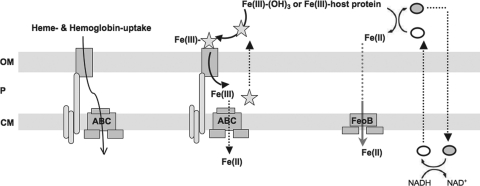Fig. 5.
A highly simplified schematic view of P. aeruginosa iron transport via phenazine-facilitated Fe(II) uptake (right), siderophore-mediated Fe(III) uptake (middle), and heme uptake (left). In Fe(III) uptake, a siderophore (e.g., pyoverdine, indicated by the star) binds extracellular Fe(III) and crosses the outer membrane (OM) via a TonB-dependent transporter (53, 64). In the periplasm, Fe(III) is released from the siderophore, which can then be recycled; Fe(III) is reduced by an unknown mechanism to Fe(II) in the periplasm (P) and transported across the cytoplasmic membrane (CM), presumably by an ABC transport system (53, 64). By contrast, phenazines can reduce extracellular Fe(III) to Fe(II). After entering the periplasm, presumably via an OM porin, Fe(II) is transported across the CM via FeoB (11, 40). Phenazines themselves are recycled (27, 73) and enter and leave the cell through various transporters (not drawn, for simplicity). Intracellularly, phenazine reduction is coupled to NADH oxidation to NAD+ (55), although whether this reduction is enzyme mediated is unknown. Reduced phenazine is indicated by the open oval and oxidized phenazine by the filled oval. Additionally, P. aeruginosa can acquire iron from heme and heme-containing proteins (e.g., hemoglobin), which are transported through a specific outer membrane receptor channel in a TonB-dependent manner (31, 48, 72). In P. aeruginosa, two distinct heme uptake systems have been found, although the mechanistic details of heme capture and delivery and the fate of heme after entering the cytoplasm are not fully understood (31, 48).

